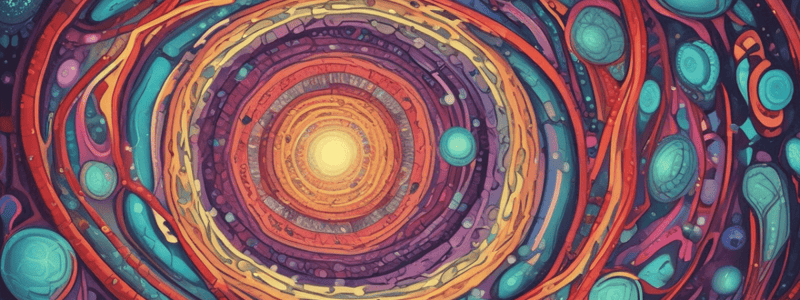Podcast
Questions and Answers
What is the primary function of the mitochondria in a cell?
What is the primary function of the mitochondria in a cell?
- Protein synthesis
- Cell division
- Energy production (correct)
- DNA replication
Which of the following is an example of a biotic factor in an ecosystem?
Which of the following is an example of a biotic factor in an ecosystem?
- Temperature
- Bacteria (correct)
- Light
- Soil
What is the term for the process by which cells become specialized to perform specific functions?
What is the term for the process by which cells become specialized to perform specific functions?
- Meiosis
- Photosynthesis
- Differentiation (correct)
- Mitosis
Flashcards are hidden until you start studying
Study Notes
Cell Biology
- Cell Structure:
- Plasma membrane: semi-permeable membrane separating cell from environment
- Cytoplasm: jelly-like substance inside cell membrane
- Nucleus: control center of cell, contains DNA
- Mitochondria: energy-producing organelles
- Ribosomes: site of protein synthesis
- Cellular Processes:
- Photosynthesis: conversion of light energy into chemical energy
- Cellular Respiration: breakdown of glucose to produce energy (ATP)
- Mitosis: process of cell division resulting in two identical daughter cells
- Meiosis: process of cell division resulting in four non-identical daughter cells (gametes)
Genetics
- Inheritance Patterns:
- Mendel's Laws: laws of inheritance ( segregation, independent assortment, dominance)
- Autosomal dominant/recessive traits: one allele dominates or is masked by another
- Sex-linked traits: genes located on sex chromosomes (X/Y)
- DNA Structure and Function:
- Double helix model: two complementary strands of nucleotides
- Genetic code: sequence of nucleotides determines amino acid sequence
- Replication: process of creating an exact copy of DNA
- Transcription: process of creating RNA from DNA template
- Translation: process of creating protein from RNA sequence
Evolution
- Evidence for Evolution:
- Fossil Record: chronological record of ancient organisms
- Comparative Anatomy: similarities and homologies between species
- Molecular Biology: similarities in DNA and protein sequences
- Mechanisms of Evolution:
- Natural Selection: process of adaptation to environment
- Genetic Drift: random change in allele frequency
- Gene Flow: exchange of genes between populations
- Mutation: change in DNA sequence
Ecology
- Ecosystems:
- Biotic factors: living components (organisms)
- Abiotic factors: non-living components (environment)
- Energy Flow: energy transfer between trophic levels
- Nutrient Cycles: recycling of nutrients
- Population Dynamics:
- Population growth/decline: changes in population size
- Limiting factors: environmental factors affecting population growth
- Carrying capacity: maximum population size an environment can support
Cell Biology
- Plasma membrane: semi-permeable membrane separating cell from environment
- Cytoplasm: jelly-like substance inside cell membrane
- Nucleus: control center of cell, contains DNA
- Mitochondria: energy-producing organelles
- Ribosomes: site of protein synthesis
Cellular Processes
- Photosynthesis: conversion of light energy into chemical energy
- Cellular Respiration: breakdown of glucose to produce energy (ATP)
- Mitosis: process of cell division resulting in two identical daughter cells
- Meiosis: process of cell division resulting in four non-identical daughter cells (gametes)
Genetics
Inheritance Patterns
- Mendel's Laws: laws of inheritance (segregation, independent assortment, dominance)
- Autosomal dominant/recessive traits: one allele dominates or is masked by another
- Sex-linked traits: genes located on sex chromosomes (X/Y)
DNA Structure and Function
- Double helix model: two complementary strands of nucleotides
- Genetic code: sequence of nucleotides determines amino acid sequence
- Replication: process of creating an exact copy of DNA
- Transcription: process of creating RNA from DNA template
- Translation: process of creating protein from RNA sequence
Evolution
Evidence for Evolution
- Fossil Record: chronological record of ancient organisms
- Comparative Anatomy: similarities and homologies between species
- Molecular Biology: similarities in DNA and protein sequences
Mechanisms of Evolution
- Natural Selection: process of adaptation to environment
- Genetic Drift: random change in allele frequency
- Gene Flow: exchange of genes between populations
- Mutation: change in DNA sequence
Ecology
Ecosystems
- Biotic factors: living components (organisms)
- Abiotic factors: non-living components (environment)
- Energy Flow: energy transfer between trophic levels
- Nutrient Cycles: recycling of nutrients
Population Dynamics
- Population growth/decline: changes in population size
- Limiting factors: environmental factors affecting population growth
- Carrying capacity: maximum population size an environment can support
Studying That Suits You
Use AI to generate personalized quizzes and flashcards to suit your learning preferences.



